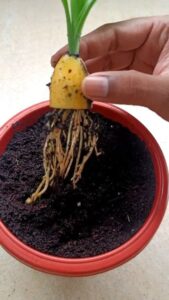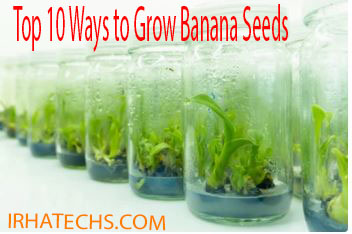Top 10 Ways to Grow Banana Seeds
Would you like to grow your own banana seeds? Picture going out into your yard and picking sweet, fresh bananas from the tree. It might sound like a tropical dream, but you can grow bananas from banana seeds, even if you don’t live in an area where bananas are normally grown. This article will show you the 10 best ways to grow banana seeds in your yard, making it look like a little tropical paradise.
People all over the world love bananas because they taste sweet, are good for you, and can be used in many different recipes. However, most people don’t know that the bananas they buy at the store are usually seedless hybrids that are grown through techniques like tissue culture and sucker division, not from seeds. Growing bananas from Banana seeds is a different and more interesting process that mostly involves wild banana varieties that produce seeds.
Banana Seeds Success: Essential Insights for Thriving Plants
| Sr.N | Aspect | Details |
| 1 | Seed Type | Wild bananas (e.g., Musa acuminate, Musa balbisiana) |
| 2 | Viability | Fresh seeds have the highest chance of successful germination |
| 3 | Optimal Conditions | Temperature: 77-86°F (25-30°C); High humidity |
| 4 | Soil Requirements | Well-draining, rich in organic matter (e.g., compost, sand) |
| 5 | Planting Depth | 1-2 inches deep |
| 6 | Watering Needs | Consistent moisture; avoid waterlogging |
| 7 | Fertilization | Balanced fertilizer every 4-6 weeks; Organic options preferred |
| 8 | Pest & Disease Control | Regular inspection; natural or organic pesticides |
| 9 | Transplanting Time | When seedlings have 2-3 true leaves |
| 10 | Harvesting Indicators | Plump, yellowing fruit; firm but slightly yielding when pressed |
| 11 | Post-Harvest Care | Store in a cool, dry place; allow further ripening if needed |
This table gives a clear summary of the key steps to grow bananas from seeds successfully.
Understand the types
There are different kinds of banana seeds. Most bananas you buy at the shop are mixes that don’t have seeds. Wild bananas, on the other hand, have seeds and are ready to grow. If you want to grow more seeds, wild types like Musa acuminate and Musa balbisiana are your best bet.
The most likely seeds to grow are those that are fresh from wild bananas. It’s possible that older seeds or seeds from dried fruits won’t grow as well. This will work best if you start with fresh, good seeds.
Choose the Right Variety
Find wild banana species that are known to grow quickly. You can choose between Musa acuminate and Musa balbisiana. These types do well in a wide range of temperatures and situations.
When picking a type, think about the weather where you live. Some bananas can handle cold better than others, and some do better in hot, tropical places. For better results, choose a type that does well in your area.
Prepare the Banana Seeds
Getting the Banana seeds out of a banana can be fun and a little messy. Be careful not to hurt the seeds as you take them out of the fruit. After the fruit is taken out, clean the seeds to get rid of any fruit leftovers. They need to be completely dry to stop mold from growing. Seeds that have been cleaned and dried properly are more likely to sprout.
The Art of Germination
To grow, banana seeds need to be warm and damp. For best results, keep the temperature between 77°F and 86°F (25°C and 30°C).
If you want to get more seeds to sprout, try scarifying them by lightly scratching the seed coat. Soaking the Banana seeds in warm water for 24 to 48 hours can also help them wake up and start growing.

Planting the Banana Seeds
Make a dirt mix that drains well and is high in organic matter. It works great to mix waste, sand, and plant soil. Put the banana seeds in the ground about 1 to 2 inches deep. Do not let the dirt become too wet. The right growing depth and amount of water are very important for the health of seedlings.
Nurture Your Seedlings
Plants that grow bananas like steady wetness but don’t like being too wet. Regularly watering them will keep the soil moist, but make sure it drains well to stop root rot.
An all-around fertilizer should be given to your plants every four to six weeks. Compost and well-rotted manure are examples of organic choices that give plants the nutrients they need to grow. Take a look out for bugs and sickness. To keep your plants healthy, check on them often and use natural or organic chemicals.
Successful Transplanting
Plant your plants when they are strong enough to handle and have at least two or three true leaves. Be careful not to hurt the plants’ roots as you take them out of their pots. Make sure the garden bed is ready for them or use bigger pots. Water them well.
Maintain Mature Plants
Pruning banana trees often helps them grow well. To encourage healthy growth, get rid of any leaves that are dead or broken and thin out any extra suckers. Banana trees need to eat and drink. Make sure they get watered often, especially when it’s dry, and feed them a balanced fertilizer to help them grow fruit. Watch out for diseases like banana bunchy top virus and Panama disease. To keep your plants healthy, you need to find problems early and treat them.
Harvesting Your Bananas
When bananas are full and beginning to turn yellow, they are ready to be picked. When you press on the fruit, it should give a little but still be hard. Use a sharp knife or scythe to cut the whole bunch off the plant. Be careful not to bruise the fruit when you handle it. Keep bananas that have been picked in a cool, dry place. If you need to, let them soften even more before you eat or sell them.
Embrace the Benefits
Growing bananas from Banana seeds enhances genetic diversity, resulting in plants that are more resilient and adaptable. Seed propagation is a sustainable method that helps decrease the need for cloning and encourages the development of healthier ecosystems. Starting bananas from Banana seeds is a more economical option compared to purchasing fully grown plants or tissue-cultured varieties.
Conclusion
Growing bananas from Banana seeds can be a fascinating and fulfilling journey. It emphasizes sustainability, enhances genetic diversity, and can be an enjoyable endeavour for gardeners at any skill level. With meticulous attention and dedication, one can saver the delightful rewards of their efforts and cultivate a small piece of heaven reminiscent of a tropical oasis right in their own backyard. So why hesitate? Embark on your banana-growing journey today and witness the flourishing of your garden!
FAQS
Do bananas have seeds?
Yes, wild bananas have seeds. However, most commercial bananas are seedless hybrids.
Does a banana have seeds?
Wild bananas do have seeds, while cultivated bananas usually do not.
Does banana have seeds?
Yes, wild varieties of banana do have seeds, which can be used for growing new plants.
Does a banana have a seed?
Yes, wild bananas can have multiple seeds within the fruit.
Does bananas have seeds?
Wild bananas do have seeds, but the bananas we commonly eat do not.
